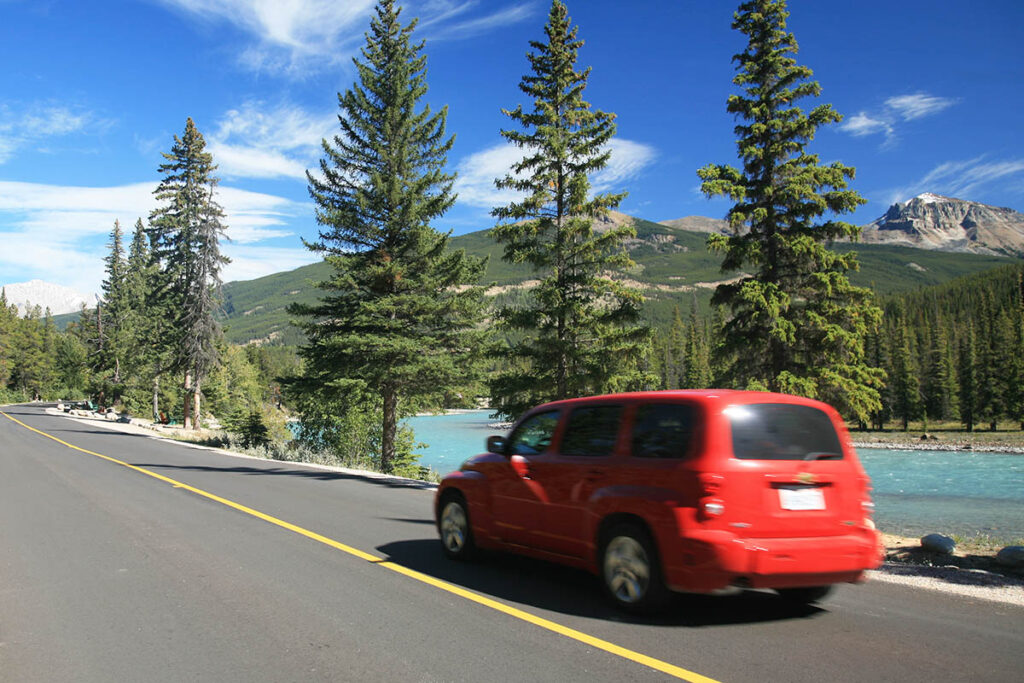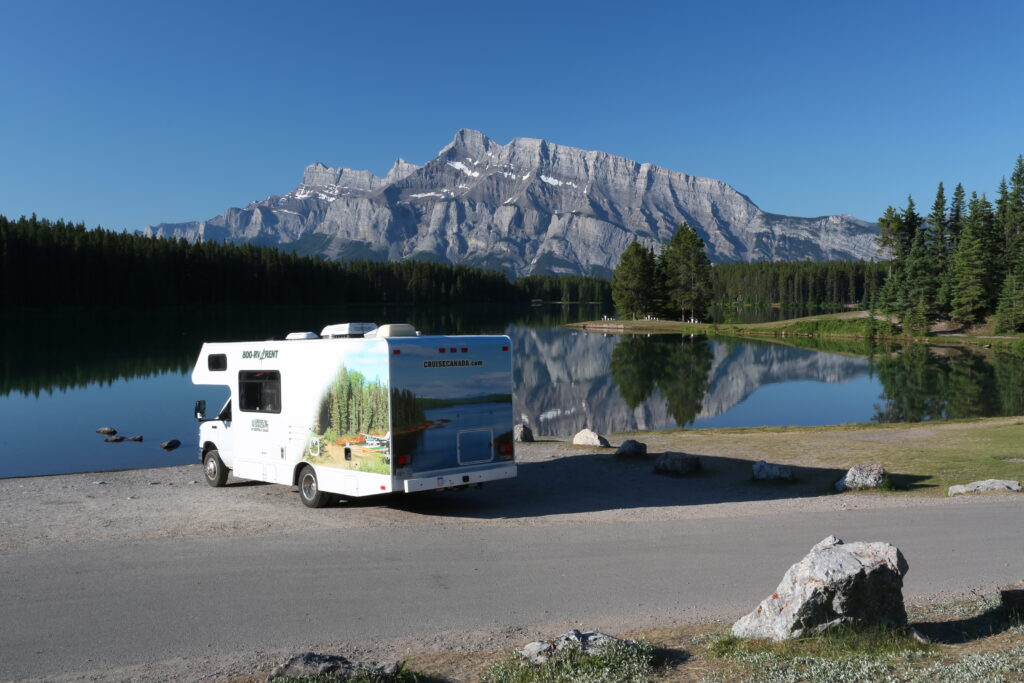Getting Around the Canadian Rockies
Getting around the Canadian Rockies is easiest with your own vehicle, but rentals are available and Banff, Lake Louise, and Canmore have excellent transit systems.
Getting Around the Canadian Rockies by Car
Getting around the Canadian Rockies by car is easy as there are paved highways linking all towns and most parks. U.S. and international driver’s licenses are valid in Canada. All highway signs give distances in kilometers and speeds in kilometers per hour. Unless otherwise posted, the maximum speed limit on the highways is 100 kph (62 mph).
Use of safety belts is mandatory, and motorcyclists must wear helmets. Infants and toddlers weighing up to nine kilograms (20 pounds) must be strapped into an appropriate children’s car seat. Use of a child car seat for larger children weighing 9-18 kilograms (20 to 40 pounds) is required of British Columbia residents and recommended to nonresidents. Before venturing north of the 49th parallel, U.S. residents should ask their vehicle insurance company for a Canadian Non-resident Inter-provincial Motor Vehicle Liability Insurance Card. You may also be asked to prove vehicle ownership, so carry your vehicle registration form.
If you’re a member in good standing of an automobile association, take your membership card–the Canadian AA provides members of related associations full services, including free maps, itineraries, excellent tour books, road- and weather-condition information, accommodations reservations, travel agency services, and emergency road services. For more information, contact the ALBERTA MOTOR ASSOCIATION or the BRITISH COLUMBIA AUTOMOBILE ASSOCIATION.
Note: Drinking and driving (with a blood-alcohol level of 0.05 percent or higher) in Canada can get you imprisoned on a first offense and will cost you your license for up to 12 months.

Most roads and highways in the Canadian Rockies are paved.
Canadian Rockies Car Rental
Canadian Rockies car rental is easy as all major car rental agencies have outlets at Calgary and Vancouver International Airports. Car rentals are also available in Banff, Canmore, and Jasper, but it is strongly recommended to rent a vehicle before arriving in the Canadian Rockies as it is often less expensive and there is more vehicle availability.
Canadian Rockies RV Rental
Canadian Rockies RV rental options include camper vans, recreational vehicles, and travel trailers, which are all great way to get around the Canadian Rockies without having to worry about accommodations each night. The downside is cost. The smallest vans, capable of sleeping two people, start at $250 per day with 100 free kilometers (62 miles) per day. Standard extra charges include insurance, a preparation fee (usually around $100 per rental), a linen/cutlery charge (around $80 per person per trip), and taxes. Major agencies, with rental outlets in both Calgary and Vancouver are CRUISE CANADA and CANADREAM. In most cases, a drop-off fee applies to drop-offs made in Vancouver from rentals originating in Calgary, or vice versa. At the end of the summer season (early September), look for online discounts.

Exploring the Canadian Rockies in an RV is popular.
Canadian Rockies Gas Stations
All towns in the Canadian Rockies have gas stations, including Banff, Lake Louise, Canmore, Jasper, Golden, Radium Hot Springs, and Bragg Creek. There are also gas stations off the main highways, including along the Icefields Parkway (summer only) and in Kananaskis Country, but expect to pay significantly more for a fill. Outside of summer, don’t rely on these more remote stations to be open. Gas station hours vary greatly, but at least one in Banff and one in Jasper opens at 6 am, and most are closed by 10 pm. To avoid summer lines at Banff and Jasper gas stations, plan on filling up earlier in the morning—waiting vehicles often spill onto surrounding streets during the middle of the day. Also note that all gas purchases in the Canadian Rockies are pre-paid, meaning you must pay at the pump prior to filling up or, in the case of those with non-Canadian credit cards, go inside and leave your credit card with the clerk.
Gasoline is sold in liters (3.78 liters equals one U.S. gallon) and is generally $1.40-1.70 per liter for regular unleaded, rising to $2 along the Icefields Parkway. Gas is generally less expensive in Alberta (Banff and Jasper), as British Columbia (Golden and Radium Hot Springs) has additional taxes. If you’re driving in from Calgary, plan on filling up in Dead Man’s Flats, which generally has the least expensive gas anywhere in the Canadian Rockies.
Use GAS BUDDY to find current prices in Banff, Canmore, and Jasper.
Getting Around the Canadian Rockies by Bus
Public transit in Banff National Park and Canmore has improved greatly in recent years. Elsewhere, getting around the Canadian Rockies is easiest with your own vehicle because public transportation is limited.
PURSUIT is primarily a tour company but also runs a scheduled bus service linking Calgary International Airport, Canmore, Banff, and Lake Louise, with a summer-only service between Lake Louise and Jasper.
The easiest way to travel around the town of Banff and between Banff, Canmore, Lake Louise, and Moraine Lake is with ROAM TRANSIT which operate regular, year-round service.
Between mid-May and early October PARKS CANADA shuttles depart for Lake Louise and Moraine Lake from Lake Louise Ski Resort. The best source of all Banff National Park transit information is pc.gc.ca/banffnow. For more information see the Lake Louise Shuttles and Getting to Moraine Lake pages.
See also Canadian Rockies Tours.
